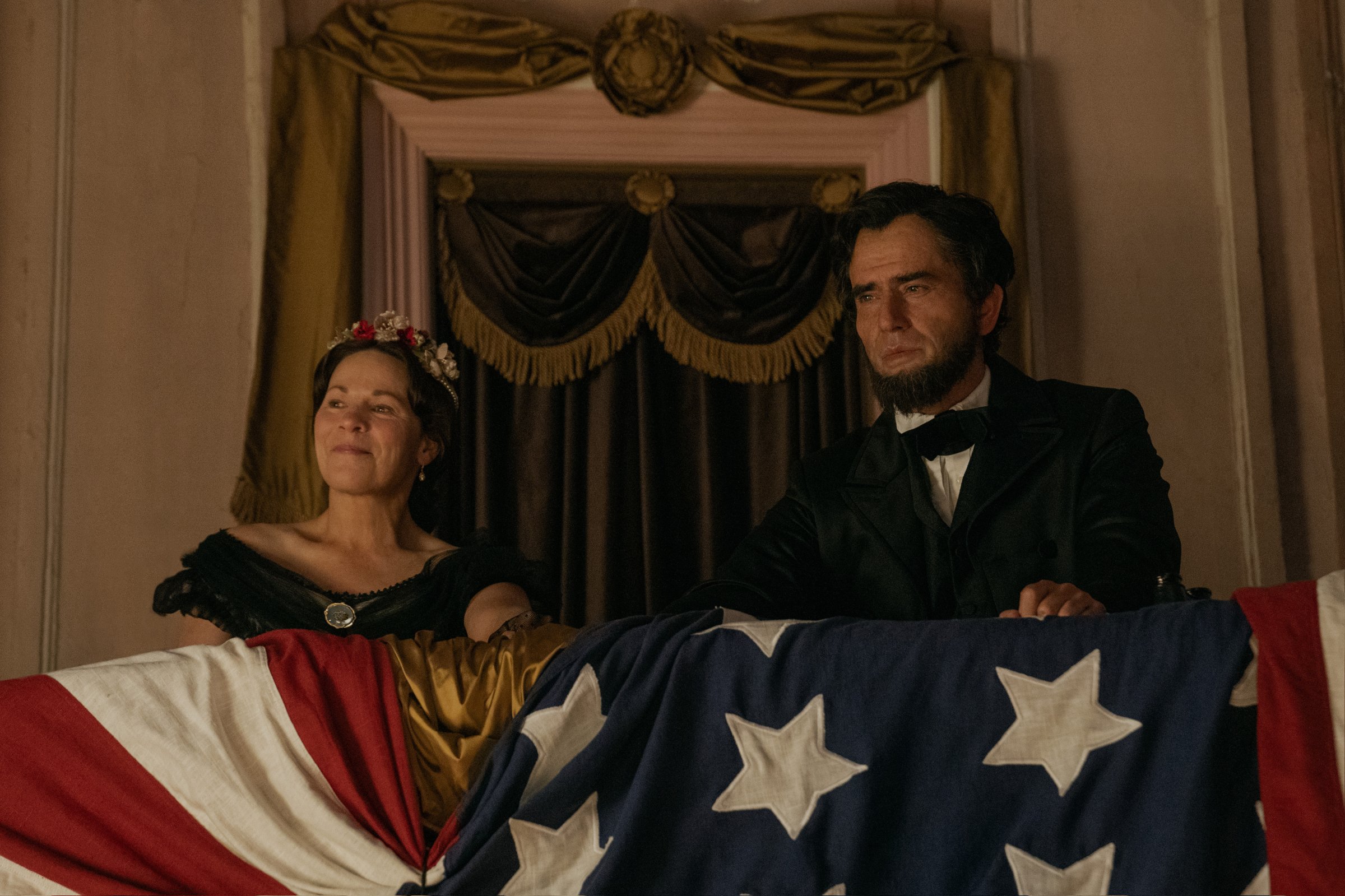
The Civil War may have officially ended on April 9, 1865, when General Robert E. Lee surrendered to Union Army General Ulysses S. Grant in Appomattox, Virginia, but tensions in the country were still high. Five days later, on April 14, 1865, actor John Wilkes Booth fatally shot President Abraham Lincoln during a play at Ford’s Theatre, marking the first time a U.S. president had been assassinated.
It was clear from the get-go that Booth had shot Lincoln; he literally jumped onto the stage and shouted Sic semper tyrannis (Latin for “thus always to tyrants”). But he managed to get away, and a 12-day manhunt ensued. The search for Booth is the basis for the show Manhunt, out March 15 on Apple TV+.
Based on James Swanson’s history book Manhunt: The 12 Day Chase for Lincoln's Killer, the seven-episode series illustrates the high-stakes search for Booth (Anthony Boyle) led by the Secretary of War Edwin Stanton (Tobias Menzies) and shows how the assassination of Lincoln (Hamish Linklater) was part of a larger conspiracy.
What happens in Manhunt?
Manhunt’s pilot opens on Lincoln’s assassination, and the rest of the series splits into two main plotlines that follow Stanton’s search for Booth and Booth on the run, respectively. As the series depicts, Booth very much wanted people to know what he had done. In Manhunt, his character chides people for not knowing who he was or not wanting to help him make his risky moves.
The show also highlights the efforts of Stanton, the manhunt’s mastermind who made key behind-the-scenes decisions during the Civil War and in the days following Lincoln’s assassination.

How Manhunt stacks up against history
Manhunt follows the people close to Booth who helped enable him to carry out the nation’s first presidential assassination. Over seven episodes, it uncovers how the assassination of Lincoln was not the only attack planned that day. A few hours before Booth shot Lincoln, he had a meeting at a hotel in which he assigned accomplices their roles. George Atzerodt (Tommie Turvey) was ordered to assassinate vice president Andrew Johnson, but did not succeed (and Johnson would succeed Lincoln). Along with David Herold (Will Harrison), ex-Confederate soldier Lewis Powell (Spencer Treat Clark) stabbed Secretary of State William Seward, but the cabinet member survived the attack. Boardinghouse owner and Confederate sympathizer Mary Surratt (Carrie Lazar) hosted Booth and conspirators in the walk-up to the assassination.
One of the reasons that Booth was able to stay on the run for so long is because he knew about a network of Confederate safehouses and pretended to be a Confederate soldier on his way home. As Manhunt shows, a physician named Samuel Mudd (Matt Walsh) treated Booth for a broken bone in his leg after assassinating Lincoln, and one of the Black Americans enslaved by Mudd, Mary Simms (Lovie Simone), provided Stanton’s team with valuable information during the manhunt by confirming that Mudd had indeed just seen Booth and was friendly with him. Black Americans also participated in the manhunt for Booth by handing out “Wanted” posters.
Read more: Our Nation Is Still Divided Along the Battle Lines of the Civil War

On April 26, 1865, Union cavalry found Booth in a tobacco barn in Virginia. When Booth refused to leave, they set it on fire and shot him. Booth’s last words were “useless, useless,” and what he meant by that remains a mystery. In July of 1865, Powell, Atzerodt, Herold, and Surratt were convicted of conspiracy to murder Lincoln and executed, while Mudd was sentenced to life in prison.
How Manhunt handles theories about Lincoln’s assassination
There are several theories as to why Booth killed Lincoln. Booth was a Confederate sympathizer who thought Lincoln was a tyrant. He also harbored dreams of fame. That ego is clear in Manhunt when Booth’s character says lines like, “I was born with chances to be somebody,” and when he shouts “freedom for the South!” after shooting Lincoln in the back of the head.
“Booth wanted to create mass confusion and disarray, and I think he hoped that he would inspire the South to fight on and change the course of the war,” Swanson tells TIME.
While Booth succeeded in becoming a household name, he couldn’t stop the progress towards civil rights. His plot did not overturn the Emancipation Proclamation, and the 13th, 14th, and 15th constitutional amendments were all eventually ratified, giving more rights to Black Americans, so Swanson argues, “Ultimately, Booth failed.”
What remains unclear is who funded Lincoln’s assassination and who put the idea to assassinate Lincoln into Booth’s head. There’s no evidence that it was Confederate States of America president Jefferson Davis. As Manhunt screenwriter and director Monica Beletsky puts it, “I think the assassination of Lincoln is an unsolved crime.”
More Must-Reads from TIME
- Cybersecurity Experts Are Sounding the Alarm on DOGE
- Meet the 2025 Women of the Year
- The Harsh Truth About Disability Inclusion
- Why Do More Young Adults Have Cancer?
- Colman Domingo Leads With Radical Love
- How to Get Better at Doing Things Alone
- Michelle Zauner Stares Down the Darkness
Write to Olivia B. Waxman at olivia.waxman@time.com